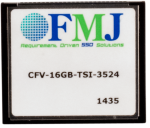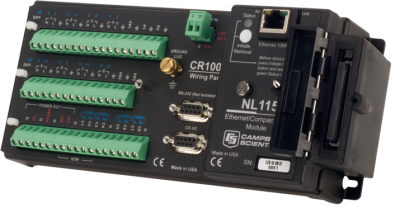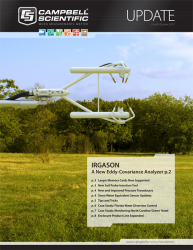Campbell Scientific’s CR1000 and CR3000 dataloggers now support CompactFlash (CF) memory cards that are larger than 2 GB. We now offer the CFMC16G, providing 16 GB of measurement data storage. This is especially relevant to high-frequency measurement applications that generate large quantities of data in short periods of time. We commonly see such applications in micrometeorology, geotechnical, and automotive areas of research. The CFMC16G is a 16 GB, industrial-grade CompactFlash card that has been selected specifically to provide optimum performance and extreme reliability. It is used with the CFM100 or NL115 to expand a datalogger's memory and to transport data, camera images, programs, and operating systems without having to use a PC.
 To accommodate large-capacity cards in an efficient manner, a new mode of operation for the CRBasic TableFile() instruction has been added to version 25 of our datalogger operating system. Using a TableFile() format option of “64” brings features similar to CardOut() to TableFile() for managing the CRD: file system. More details can be found in the CRBasic help for TableFile(), but here is an example in action:
To accommodate large-capacity cards in an efficient manner, a new mode of operation for the CRBasic TableFile() instruction has been added to version 25 of our datalogger operating system. Using a TableFile() format option of “64” brings features similar to CardOut() to TableFile() for managing the CRD: file system. More details can be found in the CRBasic help for TableFile(), but here is an example in action:
TableFile("CRD:" & Status.SerialNumber & "_Test_",64,-1,0,24,Hr,0 ,0)
You can update your CR1000 or CR3000 to OS version 25 using the following links:
- To determine your datalogger’s current operating system, please visit www.campbellsci.com/datalogger-os-updates.
- To download a datalogger operating system and compiler, please visit www.campbellsci.com/19_1_763.
- A tutorial for updating a datalogger operating system can be found at www.campbellsci.com/19_1_9999_159.
All of our CF memory cards are industrial grade and therefore offer a number of advantages over less expensive commercial-grade CF cards: they are less susceptible to failure and data loss, operate over a wider temperature range, have faster read/write times, offer better vibration and shock resistance, and have longer life spans (more read/write cycles). Additionally, CF cards in general offer a variety of advantages over Secure Digital (SD) cards, including ruggedness, ease of handling, and connection reliability. For these reasons, we have chosen to offer CF cards that are industrial grade over SD cards. More specifically, we offer and recommend the FMJ brand after having performed stringent testing for compatibility, speed, current drain, and electrostatic discharge (ESD) endurance.
Tip Says: As with all of our other memory cards, don’t forget to press the card removal button and wait for the green light before powering down the datalogger or ejecting the card.


